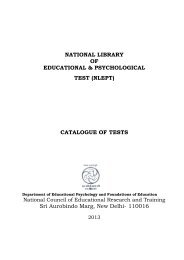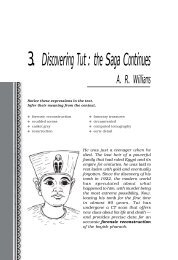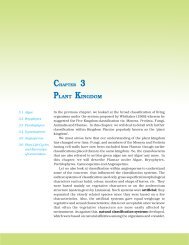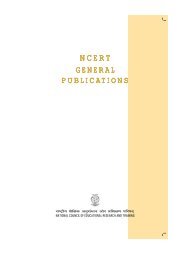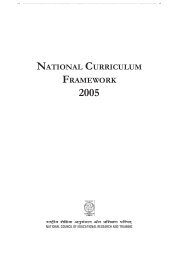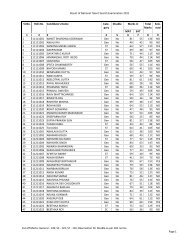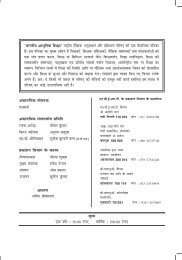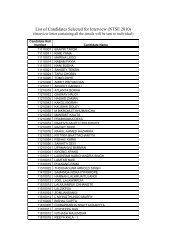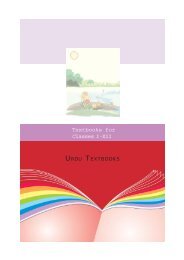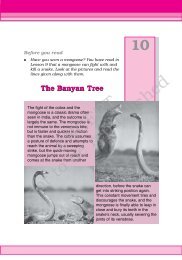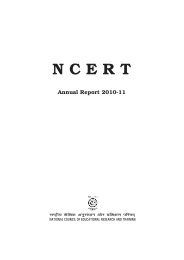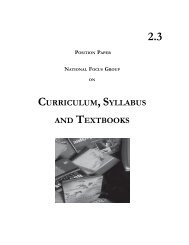indian education - National Council Of Educational Research And ...
indian education - National Council Of Educational Research And ...
indian education - National Council Of Educational Research And ...
You also want an ePaper? Increase the reach of your titles
YUMPU automatically turns print PDFs into web optimized ePapers that Google loves.
The Arts as Education 17<br />
outcomes of social activity. They are<br />
expressions or applications of creative<br />
skill and imagination through visual<br />
mediums such as painting or sculpture,<br />
or through performance such as music<br />
and dance, or acting. An art form is a<br />
conventionally established form of<br />
artistic composition, such as an oral or<br />
written text, which could be presented<br />
as a narrative composition depicted<br />
through a pata chitra 8 or rendered<br />
through kathagayaki 9 , as is done in the<br />
Pandavani 10 . Thus, the arts are subjects<br />
of study concerned primarily with human<br />
culture. This makes it necessary to<br />
investigate them “against the<br />
background of physio-geographical<br />
realities, racial strands, agricultural<br />
functions and social organisations which<br />
have contributed in giving them a<br />
distinctive character” 11 . Parallel<br />
existence of variegated, complex streams<br />
of performing and visual art forms has<br />
created multicoloured pictures. If one<br />
views the arts as a creation that has no<br />
purpose or meaning beyond itself, it<br />
becomes what in popular parlance is<br />
known as art for art’s sake. Antithetical<br />
to this is the view that the arts are a<br />
blueprint for a better society. They have<br />
a purpose beyond being a mere display<br />
of creativity. Each of the arts –<br />
irrespective of whether they are<br />
performing, non-performing, visual – has<br />
inherent values. This makes each art a<br />
source for <strong>education</strong>, holistic in nature.<br />
Performing and non-performing art<br />
forms in India have, down the ages, been<br />
coupled with the community’s world<br />
view. They have been handed down from<br />
one generation to the next, creating an<br />
oral tradition of transmitting knowledge.<br />
Within the performing arts, singing,<br />
playing of musical instruments, dancing,<br />
acting, recitation, narration, acrobatic<br />
feats along with visual components such<br />
as crafts, attire, weaving, drawing and<br />
painting, make-up, design – these merge<br />
into a single whole. Ironically, down the<br />
years, each integral unit has been,<br />
segregated from the other. This<br />
segregation might have achieved the<br />
small aim of giving these areas an<br />
individual status as solo art forms. But<br />
it has, in the process, tended to reduce<br />
their size and stature. Each of these<br />
areas has a philosophy, sociology,<br />
history, language, vocabulary and a<br />
cultural idiom, fusing to become an<br />
integrated whole through rendition or<br />
depiction.<br />
The Cross-curricular Character of<br />
the Arts<br />
There are two ways of looking for a<br />
relationship between the performing arts<br />
and the other subjects. One way would<br />
be to look for the arts and aesthetics in<br />
areas of other subjects, for investigating<br />
to what extent the arts have been<br />
Economics<br />
Commerce<br />
Language<br />
Arts<br />
History<br />
Sociology<br />
Geography Technology<br />
Science<br />
Environmental<br />
Studies<br />
Fig. 1: Looking for the arts in different<br />
subjects



